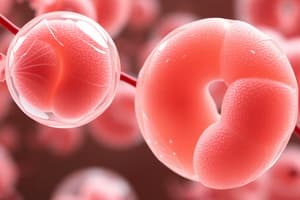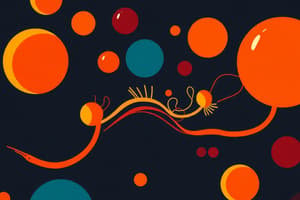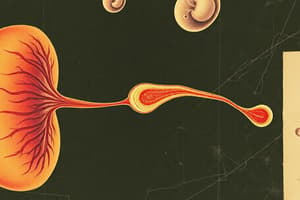Podcast
Questions and Answers
In majority of sexually reproducing organisms, the gametes are:
In majority of sexually reproducing organisms, the gametes are:
- homogametes
- hemigametes
- heterogametes (correct)
- isogametes
Autogamy is best described as:
Autogamy is best described as:
- the transfer of pollen grains from the anther to the stigma of the same flower (correct)
- the maturation of anther and stigma at different times
- the transfer of pollen grains from the anther to the stigma of a different flower
- the dehiscence of anther and release of pollen grains
Which type of questions are included in Section B of the paper?
Which type of questions are included in Section B of the paper?
- Multiple choice questions of one mark
- Long answer type questions of five marks
- Case-based short answer type questions
- Short answer type I questions of two marks (correct)
The maximum marks for the biology sample paper is:
The maximum marks for the biology sample paper is:
How many total questions are there in the sample paper?
How many total questions are there in the sample paper?
In which section does not have any overall choice?
In which section does not have any overall choice?
Which section contains case-based short answer type questions?
Which section contains case-based short answer type questions?
How many long answer type questions are in Section E?
How many long answer type questions are in Section E?
What condition arises when a person has two copies of the HbS allele?
What condition arises when a person has two copies of the HbS allele?
What is the expected probability of having a normal child when a homozygous female for the HbS allele has children with a heterozygous male?
What is the expected probability of having a normal child when a homozygous female for the HbS allele has children with a heterozygous male?
In the context of inheritance, which type of disorder is haemophilia classified as?
In the context of inheritance, which type of disorder is haemophilia classified as?
What might explain the low population of mosses and ferns in biodiversity?
What might explain the low population of mosses and ferns in biodiversity?
Which group of plants is generally considered the most advanced based on biodiversity classifications?
Which group of plants is generally considered the most advanced based on biodiversity classifications?
What is the main environmental consequence of excessive use of urea and phosphate fertilizers in crops?
What is the main environmental consequence of excessive use of urea and phosphate fertilizers in crops?
What effect does the spraying of DDT have on aquatic ecosystems?
What effect does the spraying of DDT have on aquatic ecosystems?
What can be concluded about the pedigree chart showing a trait absent in parents but present in the next generation?
What can be concluded about the pedigree chart showing a trait absent in parents but present in the next generation?
Why might couples consider sterilization as a last contraceptive option?
Why might couples consider sterilization as a last contraceptive option?
What distinguishes sticky ends in DNA strands from blunt ends?
What distinguishes sticky ends in DNA strands from blunt ends?
What could explain the lack of DNA bands in an ethidium bromide-stained agarose gel?
What could explain the lack of DNA bands in an ethidium bromide-stained agarose gel?
What is the role of the placenta in the relationship between the fetus and the maternal body?
What is the role of the placenta in the relationship between the fetus and the maternal body?
Why is only a small percentage of genetic information transcribed into functional RNA in mammalian cells?
Why is only a small percentage of genetic information transcribed into functional RNA in mammalian cells?
What factor increases the risk of a haemophilic child in a non-haemophilic couple?
What factor increases the risk of a haemophilic child in a non-haemophilic couple?
Which of the following represents a genotype of a haemophilic child?
Which of the following represents a genotype of a haemophilic child?
How many chromosomes would be present in the gametes if a plant's meiocyte has 24 chromosomes?
How many chromosomes would be present in the gametes if a plant's meiocyte has 24 chromosomes?
What part of the flower develops into the fruit?
What part of the flower develops into the fruit?
Which organ is primarily responsible for the ovulation process in females?
Which organ is primarily responsible for the ovulation process in females?
What is the causative agent of AIDS?
What is the causative agent of AIDS?
Which symptom is NOT associated with amoebic dysentery caused by Entamoeba histolytica?
Which symptom is NOT associated with amoebic dysentery caused by Entamoeba histolytica?
What is the primary mode of transmission for Entamoeba histolytica?
What is the primary mode of transmission for Entamoeba histolytica?
What is one of the measures taken by the Indian government to control vehicular air pollution?
What is one of the measures taken by the Indian government to control vehicular air pollution?
What is the primary reason for new species evolving at a faster rate?
What is the primary reason for new species evolving at a faster rate?
In an ecological pyramid, what does the base typically represent?
In an ecological pyramid, what does the base typically represent?
Which restriction enzyme would most likely be used to introduce a foreign gene into the ampR region of pBR322?
Which restriction enzyme would most likely be used to introduce a foreign gene into the ampR region of pBR322?
What is the primary reason activated sludge should settle quickly?
What is the primary reason activated sludge should settle quickly?
What is the causative agent of typhoid?
What is the causative agent of typhoid?
Which modes of transmission for HIV are correct?
Which modes of transmission for HIV are correct?
What is the function of β-galactosidase in E.coli?
What is the function of β-galactosidase in E.coli?
What may prevent a bacterial cell from producing a desired human protein after transformation?
What may prevent a bacterial cell from producing a desired human protein after transformation?
What are the symptoms of pneumonia?
What are the symptoms of pneumonia?
Which of the following describes Organism A and B as conformers or regulators?
Which of the following describes Organism A and B as conformers or regulators?
What concept is illustrated by the connection between different trophic levels in an ecosystem?
What concept is illustrated by the connection between different trophic levels in an ecosystem?
What is the role of an antibiotic resistance gene in a vector?
What is the role of an antibiotic resistance gene in a vector?
What is the outcome if a bacterial cell incorporates a human gene with introns?
What is the outcome if a bacterial cell incorporates a human gene with introns?
What method is ineffective for preventing HIV transmission?
What method is ineffective for preventing HIV transmission?
Which scenario depicts a typical response of conformers?
Which scenario depicts a typical response of conformers?
Flashcards
What are heterogametes?
What are heterogametes?
Gametes are reproductive cells (like sperm and egg) that combine to form a zygote. Most organisms produce different types of gametes - one larger and one smaller, making them heterogametes.
What is autogamy?
What is autogamy?
Autogamy is a type of self-fertilization where the pollen from the anther of a flower pollinates the stigma of the same flower.
What are Isogametes?
What are Isogametes?
Isogametes are gametes (sex cells) of the same size and morphology (structure). They are identical in appearance.
What are Homogametes?
What are Homogametes?
Signup and view all the flashcards
What are Hemigametes?
What are Hemigametes?
Signup and view all the flashcards
What is pollination?
What is pollination?
Signup and view all the flashcards
What is the significance of anther and stigma maturation at different times?
What is the significance of anther and stigma maturation at different times?
Signup and view all the flashcards
What is dehiscence of anther?
What is dehiscence of anther?
Signup and view all the flashcards
Why should activated sludge settle quickly?
Why should activated sludge settle quickly?
Signup and view all the flashcards
How is AIDS transmitted?
How is AIDS transmitted?
Signup and view all the flashcards
Why might a bacterial cell not produce the desired protein after transformation with a human gene?
Why might a bacterial cell not produce the desired protein after transformation with a human gene?
Signup and view all the flashcards
What are conformers and regulators?
What are conformers and regulators?
Signup and view all the flashcards
What is an antibiotic resistance gene used for?
What is an antibiotic resistance gene used for?
Signup and view all the flashcards
What are some potential causes of fish mortality in a lake?
What are some potential causes of fish mortality in a lake?
Signup and view all the flashcards
What is the importance of the cell membrane?
What is the importance of the cell membrane?
Signup and view all the flashcards
What is the scientific method?
What is the scientific method?
Signup and view all the flashcards
Eutrophication
Eutrophication
Signup and view all the flashcards
Autosomal Recessive Inheritance Pattern
Autosomal Recessive Inheritance Pattern
Signup and view all the flashcards
Sterilization: Last Resort
Sterilization: Last Resort
Signup and view all the flashcards
Mitosis in Haploids
Mitosis in Haploids
Signup and view all the flashcards
Placenta: Fetal-Maternal Bridge
Placenta: Fetal-Maternal Bridge
Signup and view all the flashcards
Sticky Ends
Sticky Ends
Signup and view all the flashcards
Selective Transcription
Selective Transcription
Signup and view all the flashcards
Thymus Removal: Immune Deficiency
Thymus Removal: Immune Deficiency
Signup and view all the flashcards
Hemophilia
Hemophilia
Signup and view all the flashcards
Genotype
Genotype
Signup and view all the flashcards
How can a trait have multiple forms?
How can a trait have multiple forms?
Signup and view all the flashcards
Why is the number of chromosomes important?
Why is the number of chromosomes important?
Signup and view all the flashcards
What is a gamete?
What is a gamete?
Signup and view all the flashcards
What is fertilization?
What is fertilization?
Signup and view all the flashcards
What is ovulation?
What is ovulation?
Signup and view all the flashcards
What is pregnancy?
What is pregnancy?
Signup and view all the flashcards
Sickle-cell anemia: Heterozygote Advantage
Sickle-cell anemia: Heterozygote Advantage
Signup and view all the flashcards
Homozygous for Sickle-cell Allele
Homozygous for Sickle-cell Allele
Signup and view all the flashcards
Heterozygous for Sickle-cell Allele
Heterozygous for Sickle-cell Allele
Signup and view all the flashcards
Color Blindness
Color Blindness
Signup and view all the flashcards
What are some measures India has taken to reduce vehicular air pollution?
What are some measures India has taken to reduce vehicular air pollution?
Signup and view all the flashcards
What positive environmental outcomes have resulted from these regulations?
What positive environmental outcomes have resulted from these regulations?
Signup and view all the flashcards
How do human actions influence evolution?
How do human actions influence evolution?
Signup and view all the flashcards
What is a pyramid of biomass and what do the base and apex indicate?
What is a pyramid of biomass and what do the base and apex indicate?
Signup and view all the flashcards
Give examples of ecological pyramids with respect to number and biomass.
Give examples of ecological pyramids with respect to number and biomass.
Signup and view all the flashcards
What is the molecule 'X' synthesized by the 'i' gene and how is it inactivated?
What is the molecule 'X' synthesized by the 'i' gene and how is it inactivated?
Signup and view all the flashcards
Which structural gene codes for β-galactosidase?
Which structural gene codes for β-galactosidase?
Signup and view all the flashcards
When does the transcription of the lac operon stop?
When does the transcription of the lac operon stop?
Signup and view all the flashcards
Study Notes
General Instructions
- Biology Class XII (2019-20)
- Sample Paper-1
- 27 questions, 5 sections
- All questions are compulsory
- Section A: multiple choice (1 mark each, Q1-5)
- Section B: short answer type I (2 marks each, Q6-12)
- Section C: short answer type II (3 marks each, Q13-21)
- Section D: case-based short answer (3 marks each, Q22-24)
- Section E: long answer type (5 marks each, Q25-27)
- No overall choice, internal choices provided in some questions
Section A - Multiple Choice Questions
- Q1: Gametes in most sexually reproducing organisms are heterogametes (different)
- Autogamy: Pollen transfer within the same flower
- Activated sludge: Quickly settling for efficient water purification, absorbing pollutants.
- AIDS transmission: HIV transmitted via blood transfusion, sexual contact, and infected blood
- Q3(cont.): • (ii) & (iv) are incorrect modes of transmission. • (i) and (iii) are correct HIV transmission modes.
Section B - Short Answer Type I
- Q6: Lake fish mortality possibly due to urea/fertilizers, pesticide use (DDT), phytoplankton decline. • Three reasons explain the fish mortality in the lake. • Phytoplankton decline and increase in pollutants could lead to fish mortality.
- Q7: Pedigree indicates trait is inherited. The trait is inherited in a sex-linked dominant pattern
- Q8: Sterilization is the last resort due to the risk of side effects or irreversibility.
- Q9: Haploid organisms produce gametes by mitosis, yet meiosis still occurs.
- Q10: Sticky ends form on DNA strands during restriction enzyme cuts, making them useful in genetic engineering. They are called sticky ends due to the single-stranded overhangs.
- Q11: Only about 1% of DNA is transcribed because of gene regulation mechanisms. Mechanisms control which genes are expressed.
- Q12: Thymus removal in a 15-year-old affects their immune system causing defects in T-cell immunity.
Section C - Short Answer Type II
- Q13: Bacterial colonies with cloning vector A are colorless, while those with cloning vector B are blue due to the chromogenic substrate. This is used to identify recombinant cells. • DNA is not visible in the agarose gel because of electrophoresis issues.
- Q14: Haemophilia is an X-linked recessive disorder. Doctors suspect haemophilia in a child because one parent carries the disease's recessive allele. • Possible genotype for non-haemophilic couple = XHXh and XHY
- Q15: Conditions for diploid cell development= suitable environment and proper nutrition • Chromosomes in a plant meiocyte is 24, gamete has 12 and zygote has 24
- Q16: Parts of the flower are labeled, followed by a discussion on seed and fruit development in relation to the flower parts and their roles. (specific parts)
- Q17: Column I contains female organs and column II contains their functions such as ovulation, fertilization. • Acrosome and sperm tails' function in reproduction.
- Q18: AIDS meaning, causes and the details of the causative agent, How AIDS is transmitted, • Ankit's colleague's perspective is not valid as it's based on misconceptions.
Section D - Case Based Short Answer Type
- Q19: Entamoeba histolytica transmission, Symptoms and prevention measures
- Q20: Indian government's measures to control vehicular air pollution and their environmental effects
- Q21: New species evolution and anthropogenic impact on the evolutionary process via examples, illustrating a short timescale.
- Q22: Ecological pyramid types (numbers, biomass, energy), base (producers) and apex (top consumers) meanings in ecological systems and specific examples.
- Q23: Detailed analysis of the given image to provide suitable answers based on the provided figure. Specific labelling and specific descriptions of the enzymes.
- Q24: Molecule functioning in gene regulation (molecule "X", synthesised by 'i' gene), inactivation, structural gene, and transcription stopping time. Discussion of the details of the labelled parts in the diagram.
Section E - Long Answer Type
- Q25: Viral and Bacterial disease details including causative agents, symptoms, and infection methods
- Q26: • Single point mutation causing sickle-cell anaemia (Hbs). • Work out a cross; probability of normal/diseased child; Discuss the advantage of heterozygous condition. • Detailed analysis of the specific cases involving inheritance and advantages of both conditions (sickle-cell and haemophilia)
- Q27: Biodiversity of plants, analysis of the given figure (Endangered and other plant groups) and explanation of the specific and detailed explanations of fungi and their conservation, biodiversity and conservation discussion.
Studying That Suits You
Use AI to generate personalized quizzes and flashcards to suit your learning preferences.




